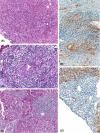Chronic Hepatitis E is associated with cholangitis
- PMID: 31102493
- PMCID: PMC6790616
- DOI: 10.1111/liv.14137
Chronic Hepatitis E is associated with cholangitis
Abstract
Background and aims: Sporadic hepatitis E is an emerging indigenous disease in Europe induced by genotype 3 of the virus. While the disease takes an acute self-limited course in immunocompetent individuals, under immunocompromised conditions chronic hepatitis E might develop. The histology of chronic hepatitis E has not been described in detail systematically.
Methods: Liver biopsies from 19 immunosuppressed patients with chronic hepatitis E were collected: 17 were organ transplant recipients, one had a CD4-deficiency and one had received steroid therapy because of ulcerative colitis. Biopsies were processed with standard stains. Evaluation of histologic activity and fibrosis was performed according to Ishak. Additionally, immunohistochemistry with antibodies directed against open reading frame 2 and 3 of the virus was performed and liver biopsies were tested for hepatitis E virus RNA.
Results: Biochemical data showed an increase in alanine transaminase, aspartate transaminase, gamma-glutamyl transferase and total bilirubin. Histopathology displayed typical features of chronic hepatitis with mild to moderate activity. The number of polymorphonuclear leucocytes was considerably increased and all patients had a florid cholangitis that presented as a destructive form in five of them. Hepatocytes and bile duct epithelia stained positive for hepatitis E virus by immunohistochemistry.
Conclusions: Chronic hepatitis E in immunocompromised individuals runs a similar course as hepatitis B and C and shows similar histopathology. However, the presence of destructive cholangitis in some cases accompanied by an increased number of polymorphonuclear leucocytes is markedly different. Immunohistochemically the virus is present in bile duct epithelia, seemingly the cause for cholangitis.
Keywords: HEV genotype 3; immunohistochemistry; immunosuppression; solid organ transplantation.
© 2019 The Authors. Liver International published by John Wiley & Sons Ltd.
Conflict of interest statement
There is no conflict to disclose.
Figures

Similar articles
-
[Hepatitis E virus: A new entity].Ann Pathol. 2010 Dec;30(6):432-8. doi: 10.1016/j.annpat.2010.10.003. Epub 2010 Nov 26. Ann Pathol. 2010. PMID: 21167429 Review. French.
-
Hepatitis E virus infection in a liver transplant recipient in the United States: a case report.Transplant Proc. 2013 Mar;45(2):810-3. doi: 10.1016/j.transproceed.2012.08.020. Transplant Proc. 2013. PMID: 23498824
-
Hepatitis E Virus Seroprevalence Among Liver Transplant Recipients with Persistent Elevation of Liver Enzymes: A Single Center Report.Arch Iran Med. 2021 Jan 1;24(1):22-26. doi: 10.34172/aim.2021.04. Arch Iran Med. 2021. PMID: 33588564
-
Clinical features and determinants of chronicity in hepatitis E virus infection.J Viral Hepat. 2019 Apr;26(4):414-421. doi: 10.1111/jvh.13059. Epub 2019 Feb 5. J Viral Hepat. 2019. PMID: 30636092 Free PMC article. Review.
-
Influence of immunosuppressive therapy on the natural history of genotype 3 hepatitis-E virus infection after organ transplantation.Transplantation. 2010 Feb 15;89(3):353-60. doi: 10.1097/TP.0b013e3181c4096c. Transplantation. 2010. PMID: 20145528
Cited by
-
Favourable outcome of acute hepatitis E infection in patients with ANCA-associated vasculitis.Orphanet J Rare Dis. 2022 Dec 13;17(1):433. doi: 10.1186/s13023-022-02586-1. Orphanet J Rare Dis. 2022. PMID: 36514177 Free PMC article.
-
Pharmacological perspectives and molecular mechanisms of coumarin derivatives against virus disease.Genes Dis. 2021 Apr 20;9(1):80-94. doi: 10.1016/j.gendis.2021.03.007. eCollection 2022 Jan. Genes Dis. 2021. PMID: 35005109 Free PMC article. Review.
-
Autoimmune liver disease-associated serologic profiling in Chinese patients with acute hepatitis E virus infection.Immunol Res. 2021 Feb;69(1):81-89. doi: 10.1007/s12026-021-09178-4. Epub 2021 Jan 28. Immunol Res. 2021. PMID: 33507492 Free PMC article.
-
Recapitulating hepatitis E virus-host interactions and facilitating antiviral drug discovery in human liver-derived organoids.Sci Adv. 2022 Jan 21;8(3):eabj5908. doi: 10.1126/sciadv.abj5908. Epub 2022 Jan 19. Sci Adv. 2022. PMID: 35044825 Free PMC article.
-
Macrophage-augmented organoids recapitulate the complex pathophysiology of viral diseases and enable development of multitarget therapeutics.Nat Biomed Eng. 2025 Jun 13. doi: 10.1038/s41551-025-01417-5. Online ahead of print. Nat Biomed Eng. 2025. PMID: 40514432
References
-
- Rein DB, Stevens GA, Theaker J, Wittenborn JS, Wiersma ST. The global burden of hepatitis E virus genotypes 1 and 2 in 2005. Hepatology. 2012;55(4):988‐997. - PubMed
-
- Purcell RH, Emerson SU. Hepatitis E: an emerging awareness of an old disease. J Hepatol. 2008;48(3):494‐503. - PubMed
-
- Sayed IM, Vercouter AS, Abdelwahab SF, Vercauteren K, Meuleman P. Is hepatitis E virus an emerging problem in industrialized countries? Hepatology. 2015;62(6):1883‐1892. - PubMed
Publication types
MeSH terms
Substances
LinkOut - more resources
Full Text Sources
Research Materials

